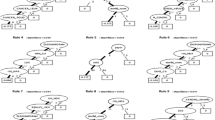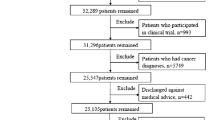Abstract
The objective of this study was to design and develop a predictive model for 30-day risk of hospital readmission using machine learning techniques. The proposed predictive model was then validated with the two most commonly used risk of readmission models: LACE index and patient at risk of hospital readmission (PARR). The study cohort consisted of 180,118 admissions with 22,565 (12.5%) of actual readmissions within 30 days of hospital discharge, from 01 Jan 2015 to 31 Dec 2016 from two Auckland-region hospitals. We developed a machine learning model to predict 30-day readmissions using the model types XGBoost, Random Forests, and Adaboost with decision stumps as a base learner with different feature combinations and preprocessing procedures. The proposed model achieved the F1-score (0.386 ± 0.006), sensitivity (0.598 ± 0.013), positive predictive value (PPV) (0.285 ± 0.004), and negative predictive value (NPV) (0.932 ± 0.002). When compared with LACE and PARR(NZ) models, the proposed model achieved better F1-score by 12.7% compared with LACE and 23.2% compared with PARR(NZ). The mean sensitivity of the proposed model was 6.0% higher than LACE and 41% higher than PARR(NZ). The mean PPV was 15.9% and 14.6% higher than LACE and PARR(NZ) respectively. We presented an all-cause predictive model for 30-day risk of hospital readmission with an area under the receiver operating characteristics (AUROC) of 0.75 for the entire dataset.

Graphical abstract


Similar content being viewed by others
References
Hernandez AF, Greiner MA, Fonarow GC, Hammill BG, Heidenreich PA, Yancy CW, Peterson ED, Curtis LH (2010) Relationship between early physician follow-up and 30-day readmission among Medicare beneficiaries hospitalized for heart failure. Jama 303(17):1716–1722
Lindenauer PK, Bernheim SM, Grady JN, Lin Z, Wang Y, Wang Y, Merrill AR, Han LF, Rapp MT, Drye EE, Normand SL, Krumholz HM (2010) The performance of US hospitals as reflected in risk-standardized 30-day mortality and readmission rates for Medicare beneficiaries with pneumonia. J Hosp Med 5(6):E12–E18
Blakely T et al (2015) Updated New Zealand health system cost estimates from health events by sex, age and proximity to death: further improvements in the age of ‘big data’. N Z Med J 128(1422):13–23
Devlin N, Maynard A, Mays N (2001) New Zealand’s new health sector reforms: back to the future? BMJ: Br Med J 322(7295):1171
Ali AM et al (2017) Factors associated with 30-day readmission after primary total hip arthroplasty: analysis of 514 455 procedures in the UK National Health Service. JAMA Surg 152(12):e173949–e173949
Jurawan N, Pankhurst T, Ferro C, Nightingale P, Coleman J, Rosser D, Ball S (2017) Hospital acquired acute kidney injury is associated with increased mortality but not increased readmission rates in a UK acute hospital. BMC Nephrol 18(1):317
Rumball-Smith J, Hider P (2009) The validity of readmission rate as a marker of the quality of hospital care, and a recommendation for its definition. N Z Med J(Online) 122(1289)
Shulan M, Gao K, Moore CD (2013) Predicting 30-day all-cause hospital readmissions. Health Care Manag Sci 16(2):167–175. https://doi.org/10.1007/s10729-013-9220-8
Yam C et al (2010) Measuring and preventing potentially avoidable hospital readmissions: a review of the literature. Hong Kong Medical Journal = Xianggang yi xue za zhi 16(5):383–389
Kansagara D et al (2011) Risk prediction models for hospital readmission: a systematic review. Jama 306(15):1688–1698
Holloway JJ, Thomas JW (1989) Factors influencing read mission risk: implications for quality monitoring. Health Care Financ Rev 11(2):19–32
Maali Y, Perez-Concha O, Coiera E, Roffe D, Day RO, Gallego B (2018) Predicting 7-day, 30-day and 60-day all-cause unplanned readmission: a case study of a Sydney hospital. BMC Med Inform Decis Mak 18(1):1
van Walraven C, Dhalla IA, Bell C, Etchells E, Stiell IG, Zarnke K, Austin PC, Forster AJ (2010) Derivation and validation of an index to predict early death or unplanned readmission after discharge from hospital to the community. Can Med Assoc J 182(6):551–557
Billings J et al (2012) Development of a predictive model to identify inpatients at risk of re-admission within 30 days of discharge (PARR-30). BMJ Open 2(4):e001667
Vaithianathan R, Jiang N, Ashton T (2012) A model for predicting readmission risk in New Zealand. AUT University, Faculty of Business and Law
Ross, S., et al. Learning message-passing inference machines for structured prediction. in Computer Vision and Pattern Recognition (CVPR), 2011 IEEE Conference on. 2011. IEEE
Rajkomar A et al (2018) Scalable and accurate deep learning with electronic health records. NPJ Digit Med 1(1):18
Freitag D (2000) Machine learning for information extraction in informal domains. Mach Learn 39(2–3):169–202
Freund Y, Schapire RE (1997) A decision-theoretic generalization of on-line learning and an application to boosting. J Comput Syst Sci 55(1):119–139
Chen T, Guestrin C (2016) Xgboost: a scalable tree boosting system. In: Proceedings of the 22nd acm sigkdd international conference on knowledge discovery and data mining. ACM
Breiman L (2001) Random forests. Mach Learn 45(1):5–32
Paul M, Bougouin W, Geri G, Dumas F, Champigneulle B, Legriel S, Charpentier J, Mira JP, Sandroni C, Cariou A (2016) Delayed awakening after cardiac arrest: prevalence and risk factors in the Parisian registry. Intensive Care Med 42(7):1128–1136
Vaziri K, Pershing S, Albini TA, Moshfeghi DM, Moshfeghi AA (2015) Risk factors predictive of endogenous endophthalmitis among hospitalized patients with hematogenous infections in the United States. Am J Ophthalmol 159(3):498–504
Carpenter CR, Shelton E, Fowler S, Suffoletto B, Platts-Mills TF, Rothman RE, Hogan TM (2015) Risk factors and screening instruments to predict adverse outcomes for undifferentiated older emergency department patients: a systematic review and meta-analysis. Acad Emerg Med 22(1):1–21
Chan MK, Bhatti H, Meader N, Stockton S, Evans J, O'Connor RC, Kapur N, Kendall T (2016) Predicting suicide following self-harm: systematic review of risk factors and risk scales. Br J Psychiatry 209(4):277–283
Berry JG, Gay JC, Maddox KJ, Coleman EA, Bucholz EM, O’Neill MR, Blaine K, Hall M (2018) Age trends in 30 day hospital readmissions: US national retrospective analysis. BMJ 360:k497
Escobar GJ, Ragins A, Scheirer P, Liu V, Robles J, Kipnis P (2015) Nonelective rehospitalizations and postdischarge mortality: predictive models suitable for use in real time. Med Care 53(11):916
van Walraven C, Wong J, Forster AJ, Hawken S (2013) Predicting post-discharge death or readmission: deterioration of model performance in population having multiple admissions per patient. J Eval Clin Pract 19(6):1012–1018
Acknowledgments
We would like to thank the clinicians at Waitemata District Health Board and Auckland District Health Board for their clinical advice. We would also like to thank researchers and data scientists for their contributions.
Funding
This research was supported by the Precision Driven Health research partnership.
Author information
Authors and Affiliations
Corresponding author
Ethics declarations
Conflict of interest
The authors declare that they have no conflict of interest.
Ethical approval
This article does not contain any studies with human participants performed by any of the authors.
Additional information
Publisher’s note
Springer Nature remains neutral with regard to jurisdictional claims in published maps and institutional affiliations.
Rights and permissions
About this article
Cite this article
Baig, M.M., Hua, N., Zhang, E. et al. A machine learning model for predicting risk of hospital readmission within 30 days of discharge: validated with LACE index and patient at risk of hospital readmission (PARR) model. Med Biol Eng Comput 58, 1459–1466 (2020). https://doi.org/10.1007/s11517-020-02165-1
Received:
Accepted:
Published:
Issue Date:
DOI: https://doi.org/10.1007/s11517-020-02165-1




